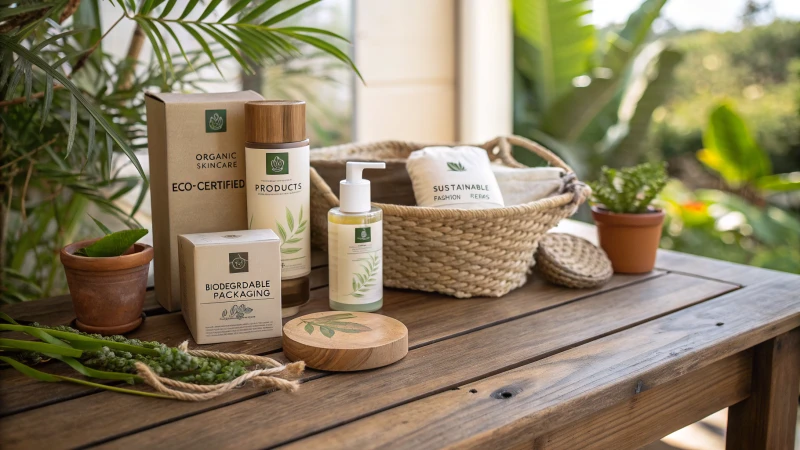
Ever felt like your product's just another face in the crowd?
To make disposable wooden cutlery brands shine in a crowded market, focus on distinct designs, secure eco-certifications, and leverage creative marketing. These strategies not only draw in eco-minded customers but also carve out a strong brand identity.
Reflecting on my journey in the eco-friendly sector, I remember the initial hurdles of distinguishing my brand. I realized that understanding what truly resonates with consumers was key. Delving into consumer preferences, keeping an eye on evolving regulations, and learning from successful examples helped me refine my approach. Consider what makes your brand unique and build on those strengths to ensure it stands apart.
Eco-certifications enhance brand credibility.True
Eco-certifications validate sustainability claims, boosting consumer trust.
Unique designs have no impact on brand differentiation.False
Distinctive designs make products memorable, aiding brand recognition.
How Can Unique Designs Make a Difference?
Ever wondered how a touch of creativity can elevate a brand from ordinary to extraordinary? Let's explore the magic of unique designs!
Unique designs differentiate brands, boost consumer attraction, and convey core values. They craft unforgettable experiences, enhance brand identity, and distinguish products in competitive landscapes, fostering customer loyalty and market growth.

The Power of Differentiation
Imagine walking into a store filled with similar products. Now, picture one item that stands out because of its striking design—maybe it's the eco-friendly packaging or an unusual shape that catches your eye. That’s the power of unique design. I remember a time when I was shopping for a new water bottle, and amidst a sea of plain ones, there was this beautifully crafted, sustainable bamboo bottle. Not only did it appeal to my eco-conscious heart, but it also made me feel like I was contributing to something bigger—our planet.
Enhancing Consumer Appeal
The magic of design doesn’t stop at standing out; it resonates deeply with people. A few months ago, I was drawn to a luxury brand's advertisement. Their use of elegant, minimalistic design wasn't just about aesthetics—it spoke to the lifestyle I aspired to. It reminded me of the sleek lines and subtle elegance that my grandmother used to appreciate in her treasured items. When design aligns with our values and aspirations, it creates a bond that goes beyond the transaction.
| Design Element | Impact on Brand |
|---|---|
| Eco-Friendly | Appeals to eco-conscious consumers, communicates sustainability |
| Minimalistic | Enhances luxury perception, aligns with premium brand identity |
| Customizable | Offers personalization, fosters customer loyalty |
Creating Memorable Experiences
Have you ever bought something because it just felt... right? That's what unique designs do—they turn a product into an experience. When I first used a phone with an intuitive, sleek interface, it wasn’t just a gadget anymore; it was an extension of my personality. Such experiences linger, helping build brand loyalty1 and ensuring repeat interactions.
Strategic Use of Design Elements
Strategic design choices can elevate a brand's narrative. I’ve seen tech companies use cutting-edge materials to echo their innovative spirit—like when I attended a tech expo where a company showcased their products with biodegradable casings. It wasn't just about being green; it was about addressing consumer needs in a way that felt fresh and responsible through design thinking2.
Incorporating unique design elements isn't just about being different for the sake of it; it's a strategic move that shapes how a brand is perceived. When we tap into the essence of design, we don't just create products—we craft stories and connections that last.
Unique designs enhance brand differentiation.True
Unique designs help brands stand out in crowded markets.
Minimalistic design decreases perceived luxury.False
Minimalistic design often increases the perception of luxury.
What Role Do Eco-Certifications Play in Brand Differentiation?
I remember the first time I saw an eco-certification on a product; it was like finding a hidden gem. It made me wonder how such a small label could hold such power in the world of brand differentiation.
Eco-certifications help brands stand out by proving their commitment to sustainability. They enhance brand reputation, attract eco-conscious consumers, and offer a competitive advantage by validating environmental claims.

Understanding Eco-Certifications
Eco-certifications are like a badge of honor for companies committed to sustainable practices. They act as third-party validations, reassuring consumers that the products they buy meet rigorous environmental standards. I once spoke with a friend who runs a small business, and he shared how eco-certifications helped him distinguish his brand3 in an ocean of similar offerings.
Building Consumer Trust
In today's world, consumers crave transparency and authenticity. When I shop, I look for those little eco-friendly symbols that act as a trust signal4, guiding me towards products that align with my values. It’s comforting to know that someone has done the legwork to verify the product’s environmental impact, making my purchasing decisions easier.
| Certification Type | Criteria | Example |
|---|---|---|
| Energy Efficiency | Reducing energy consumption | Energy Star |
| Sustainable Sourcing | Ethical material sourcing | FSC Certified |
| Biodegradability | Breakdown without harm | BPI Certified |
Enhancing Brand Reputation
Brands that proudly display eco-certifications often gain a reputation as pioneers in sustainability. A few years ago, I consulted for a company that had just received its first certification, and it was incredible to see the ripple effect on customer loyalty and advocacy. Companies showcasing their commitment to the environment5 often find themselves in favor with socially responsible investors, which can be a game-changer.
Competitive Advantage in the Market
In competitive markets, eco-certifications provide brands with a distinct edge. They allow companies to position their products as superior, often justifying premium pricing. I’ve seen how businesses can also use these certifications to enter new markets6 where sustainability is a key factor for consumers. It’s like having an exclusive pass into untapped territories where the eco-conscious market is ripe for capture.
Eco-certifications are more than just labels—they're powerful tools for differentiation, offering brands the chance to build a solid reputation, earn consumer trust, and secure a competitive advantage. As sustainability becomes increasingly important to consumers, businesses embracing these certifications are poised to thrive.
Eco-certifications increase consumer trust in brands.True
Eco-certifications validate environmental claims, fostering consumer trust.
Brands with eco-certifications cannot charge premium prices.False
Certified products are often perceived as higher quality, allowing premium pricing.
Which Innovative Marketing Strategies Are Most Effective?
Ever wonder how some brands just seem to have that magic touch in the marketing world?
Effective innovative marketing strategies often hinge on embracing digital platforms, weaving engaging storytelling, and offering personalized customer experiences. These methods not only set brands apart but also forge deeper connections with audiences.

I remember when I first dived into the world of marketing, feeling both excited and overwhelmed by the endless possibilities. It was like being handed a blank canvas with a hundred different colors to choose from. But as I navigated through this vibrant landscape, I quickly realized that certain strategies stood out, much like finding that perfect shade that completes a painting.
Leveraging Digital Platforms
Digital platforms have become the bustling marketplaces of today, each offering unique opportunities to connect directly with consumers. I vividly recall experimenting with social media advertising7 for the first time. It felt like opening a door to a vast audience, each click and comment a new brushstroke on my brand's canvas. Platforms like Instagram and TikTok became my playground, their features like stories and reels allowing me to craft short, engaging snippets of content that spoke directly to a younger crowd.
| Platform | Key Feature | Audience Engagement |
|---|---|---|
| Stories & Reels | High visual impact | |
| TikTok | Short-form videos | Viral potential |
| Community groups | Targeted interaction |
Engaging Storytelling
Storytelling has always been my secret weapon in marketing. It's amazing how a well-crafted narrative can breathe life into a brand. Think of Nike's "Just Do It" campaign—it's not just about shoes or apparel; it's a rallying cry for personal triumph and perseverance. Every time I weave a story around my products, I aim to spark a similar emotional connection, transforming mere transactions into memorable experiences.
Personalized Customer Experiences
In today's world, personalization is no longer a luxury—it's an expectation. I remember the first time I used data analytics to tailor marketing campaigns. It was like discovering a treasure map that led directly to customer satisfaction. Whether it was through personalized email marketing or curating product recommendations, these efforts fostered loyalty and encouraged repeat business. Just like Amazon does with its recommendation system, which feels almost like a personal shopping assistant suggesting what you might love next.
Incorporating AI and Machine Learning
AI and machine learning have revolutionized my approach to marketing. It's like having a crystal ball that offers insights into consumer behavior and helps fine-tune strategies. From chatbots providing instant customer service to platforms like Spotify using algorithms to curate playlists, these technologies enhance user experience and keep engagement high.
Sustainability as a Marketing Strategy
I've always believed that aligning marketing efforts with sustainability isn't just good practice—it's essential. As consumers become more eco-conscious, showcasing sustainable practices can significantly boost brand image. Companies like Patagonia have mastered this approach, attracting customers who share their values.
Implementing eco-certifications8 on products has become a powerful differentiator for my brand, assuring customers of our commitment to the environment. It's a step towards not only building trust but also contributing positively to the planet.
In essence, these innovative strategies are my toolkit for navigating the ever-changing market landscape. By embracing digital engagement, storytelling, personalization, AI technology, and sustainability, I'm able to not just survive but thrive in this competitive environment.
Instagram Stories have high visual impact.True
Instagram Stories allow brands to create visually engaging content.
AI cannot enhance customer service.False
AI, like chatbots, improves customer service by providing instant responses.
How Can Consumer Behavior Trends Shape Your Strategy?
Have you ever wondered how consumer behavior trends could be the key to refining your business strategy?
Consumer behavior trends are like a compass for businesses, offering insights into customer preferences and buying habits. By analyzing these patterns, companies can fine-tune their strategies to better meet consumer needs, enhancing marketing efforts and product development.

The Role of Consumer Behavior in Strategy Development
I've always been fascinated by how understanding consumer behavior can transform a business strategy. These trends are like clues that help decode what drives customers to choose one product over another. Think about it—by knowing what your customers really want, you can tailor your products and services to match their preferences. I remember when a friend of mine, who runs a small eco-friendly shop, started using eco-friendly packaging9 because she noticed her customers were increasingly concerned about sustainability. It wasn't just a smart move—it also attracted a whole new group of eco-conscious buyers.
Identifying Key Consumer Trends
The first step to leveraging these trends is identifying them. This means diving into data from all sorts of places—market research reports, social media chatter, and direct feedback from your customers. I've spent hours poring over customer reviews and social media comments for insights. This kind of analysis helps you anticipate future shifts and adapt your strategy before the competition even realizes what's happening.
Integrating Trends into Marketing Strategies
Once you've identified the trends, it's time to weave them into your marketing strategies. This could mean anything from launching an advertising campaign that speaks directly to your audience's interests to introducing new product lines that cater to their emerging demands. I've seen firsthand how using AI tools10 can personalize customer interactions, making them feel valued and understood, which boosts engagement in ways you'd never expect.
Case Study: Successful Trend Integration
Let me share a story about a brand that hit the nail on the head by integrating consumer trends into its strategy. They spotted a rise in demand for plant-based products and expanded their vegan offerings. It wasn't just about meeting demand—it positioned them as pioneers in innovation. I remember thinking how clever it was—they didn't just ride the wave; they helped create it.
| Trend | Strategy Implementation | Outcome |
|---|---|---|
| Eco-Consciousness | Use of sustainable materials | Increased brand loyalty |
| Personalization | Customizable product options | Enhanced customer satisfaction |
| Health & Wellness | Introduction of organic products | Broader market appeal |
Challenges in Adapting to Trends
But let's be real—adapting to consumer trends isn't always smooth sailing. It demands constant vigilance over market dynamics and often requires substantial investment in R&D. However, those who manage to navigate these challenges gain a significant edge over competitors. I once worked with a company that faced this exact issue; they had to balance innovation with practicality without derailing existing operations or blowing the budget. Learning from case studies11 of others who have faced similar hurdles can be incredibly enlightening.
Eco-friendly packaging attracts eco-conscious consumers.True
Eco-friendly packaging aligns with sustainability trends, appealing to eco-conscious consumers.
Ignoring consumer trends has no impact on business success.False
Ignoring consumer trends can lead to misalignment with market demands, affecting success.
Conclusion
Disposable wooden cutlery brands can differentiate themselves through unique designs, eco-certifications, and innovative marketing strategies to attract eco-conscious consumers and build strong brand identities.
-
Learn how distinctive designs create memorable customer experiences that foster brand loyalty and repeat business. ↩
-
Discover how businesses use design thinking to creatively solve problems and meet consumer demands effectively. ↩
-
Explores the advantages eco-certifications offer to brands, enhancing their credibility and market appeal. ↩
-
Discusses how eco-certifications build consumer trust by verifying sustainable practices. ↩
-
Examines how eco-certifications enhance a brand's reputation as a sustainability leader. ↩
-
Highlights how eco-certifications offer a competitive edge in markets prioritizing sustainability. ↩
-
Discover how social media advertising can enhance your brand's visibility and engagement through targeted campaigns. ↩
-
Learn about eco-certifications and their role in boosting consumer trust through sustainable practices. ↩
-
Discover how adopting eco-friendly packaging strategies can enhance brand appeal among sustainability-focused consumers. ↩
-
Learn how AI tools personalize customer experiences, driving higher engagement and satisfaction. ↩
-
Explore case studies of companies that have effectively adapted to consumer trends for strategic advantage. ↩

